Leveraging the 95:5 Rule to your advantage

As any seasoned B2B marketer knows, the challenge of identifying, enticing, nurturing and converting new customers isn’t easy. It requires strategic thinking, serious planning, and top notch execution across all teams to pull off.
This would be difficult enough if the potential customers for your product or service were always in-market, but the simple truth is that they are not. Our challenge is made harder by the marketing industry’s widely accepted ‘95:5 Rule’.
This rule suggests that at any given time, 95% of your potential customers are not presently in the market for your product or service, with just 5% actively seeking a solution. That’s odds of 19 to 1 against, with no way of knowing which of the 5% is in-market before you start your marketing activities. On the face of it, the odds are stacked against success, but fear not. Smart marketers can use the 95:5 Rule to their advantage. Let’s see how.

First, let's take a closer look at what the 95:5 Rule actually means. According to a Marketing Week article by Peter Weinberg and Jon Lombardo, the rule suggests that "only 5% of the market is actively seeking to buy a solution, while the remaining 95% either don't realise they have a problem or aren't interested in solving it."

The answer lies in building brand awareness and trust with this audience while they are out-of-market. Use this time to get on the radar of the 95%. Continue to stay visible and relevant throughout this period. Build a strong brand relationship so that when the time comes for them to transition to the 5% in-market, you’re already on their mind and in consideration.
A LinkedIn B2B Institute study found that the most successful B2B brands are those that are equally well-known and respected, even among customers who aren't currently in the market for their products or services. By building a strong brand and establishing a reputation for excellence, marketers can lay the foundation for future sales and attract customers who may not have been actively seeking a solution.

Harmonising brand and user experience
There are several key strategies and tactics that are essential for building successful brand awareness. Often overlooked is the importance of harmonising brand and user experience within an organisation or business. Simply put, it’s not enough to just attract the 95% to your brand; their subsequent experience with you - across all touchpoints - needs to enhance your brand.
This sounds obvious, but all too often user experience can undermine a brand by not living up to expectations. If you can harmonise brand and user experience, you’ll be better placed to target the 95% through a number of channels, including:
- Content marketing: By creating and sharing valuable, informative content, marketers can establish themselves as thought leaders in their industry and build trust with potential customers.
- Thought leadership: In addition to content marketing, marketers can establish themselves as experts in their field by publishing research, speaking at industry events (such as Round Tables), and participating in industry associations.
- Social media: Social media can be a powerful tool for building brand awareness and engaging with potential customers. By sharing valuable content and engaging with the 95%, marketers can build a loyal following and establish a strong online presence.
- Personalisation: Finally, marketers can use personalisation to tailor their messaging and content to the specific needs and interests of their target audience. By delivering personalised content and messaging, you can increase the relevance and effectiveness of marketing efforts.
Next Steps
The 95:5 Rule is an important concept for marketers to understand. By recognising that the majority of potential customers are not actively seeking a solution, marketers can focus on building brand awareness and trust.
If you’d like to learn more on how to leverage the 95:5 Rule to your advantage, have a conversation with Cite. We’re here to help you achieve long-term growth and success.



